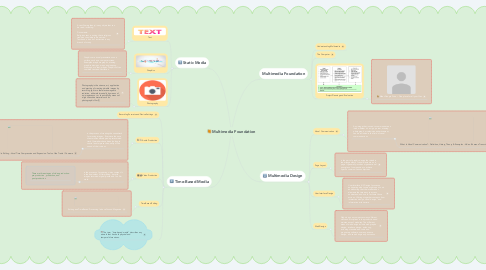
1. Static Media
1.1. Text
1.1.1. A text (literary theory) is any object that can be read, including: Documents: Religious text, a writing that a religious tradition considers to be sacred Textbook, a book of instruction in any branch of study
1.2. Graphics
1.2.1. Graphics are visual presentations on a surface, such as a computer screen. Examples are photographs, drawing, graphics designs, maps, engineering drawings, or other images. Graphics often combine text and illustration.
1.3. Photography
1.3.1. Photography is the science, art, application and practice of creating durable images by recording light or other electromagnetic radiation, either electronically by means of an image sensor, or chemically by means of a light-sensitive material such as photographic film.[1]
2. Time-Based Media
2.1. Recording Formats and Device Settings
2.2. Audio Production
2.2.1. is the process of creating the soundtrack for moving images. Ever since the once silent movies developed a prerecorded track, filmmakers have been looking to control and improve the quality of the sound of their visions
2.2.1.1. Time Based Audio Editing - Vocal Time Compression and Expansion: Tools of the Trade | Coursera
2.3. Video Production
2.3.1. is the process of producing video content. It is the equivalent of filmmaking, but with images recorded digitally instead of on film stock.
2.3.1.1. There are three stages of video production: pre-production, production, and post-production
2.4. Time-Based Editing
2.4.1. Editing and Time Based Processing | aboveGround Magazine
2.5. The term "time-based media" describes any artwork that has both physical and temporal dimensions.
3. Multimedia Foundation
3.1. Understanding Multimedia
3.2. The Computer
3.3. Project Planning and Evaluation
3.3.1. Meet Google Drive – One place for all your files
4. Multimedia Design
4.1. Visual Communication
4.1.1. Any image that is used to communicate an idea, whether it's a sign, poster, drawing, photograph, or television advertisement, can be included in the field of visual communications
4.1.1.1. What Is Visual Communication? - Definition, History, Theory & Examples - Video & Lesson Transcript | Study.com
4.2. Page Layout
4.2.1. is the part of graphic design that deals in the arrangement of visual elements on a page. It generally involves organizational principles of composition to achieve specific communication objectives.
4.3. User Interface Design
4.3.1. User Interface (UI) Design focuses on anticipating what users might need to do and ensuring that the interface has elements that are easy to access, understand, and use to facilitate those actions. UI brings together concepts from interaction design, visual design, and information architecture.
4.4. Web Design
4.4.1. Web design encompasses many different skills and disciplines in the production and maintenance of websites. The different areas of web design include web graphic design; interface design; authoring, including standardised code and proprietary software; user experience design; and search engine optimization

